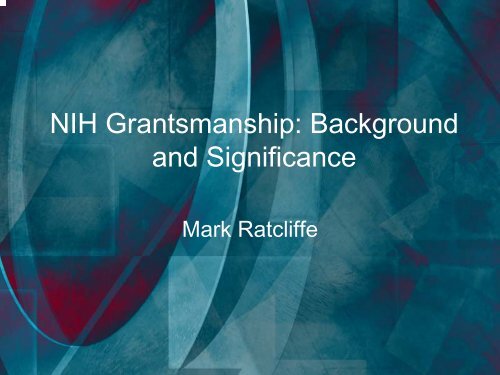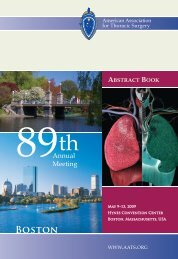Background and Significance
Background and Significance
Background and Significance
Create successful ePaper yourself
Turn your PDF publications into a flip-book with our unique Google optimized e-Paper software.
NIH Grantsmanship: <strong>Background</strong><strong>and</strong> <strong>Significance</strong>Mark Ratcliffe
On line resourcesNIH Grantsmanship Site:http://www.niaid.nih.gov/ncn/grants/write/index.htmAHA Grant Writing Tips:http://www.heart.org/downloadable/heart/1133366256870Grantwriting_Tips.pdf
General Comments• Find out in advance as much as possibleabout the potential reviewers. 1• Study section rosters can be found at:http://www.csr.nih.gov/Committees/rosterindex.asp1. Inouye SD <strong>and</strong> Fiellin DA, Ann Int Med 142:274 2005
A typical grant reviewer
A typical study section
General Comments• Make your grant easy to read.• Tell a story.• “It would be good if your (husb<strong>and</strong>)/ wife canunderst<strong>and</strong>.” 1• “Err on the side of starting off simple. Write theengineering part for the surgeons <strong>and</strong> the clinicalpiece for the engineers.” 11. Rob Gorman, CT Surgery, UPenn
FontUse an Arial, Helvetica, Palatino Linotype or Georgiatypeface <strong>and</strong> a font size of 11 points or larger. (A Symbolfont may be used to insert Greek letters or specialcharacters; the font size requirement still applies.)Type density, including characters <strong>and</strong> spaces, must be nomore than 15 characters per inch.Type may be no more than six lines per inch.Use black ink that can be clearly copied.Print must be clear <strong>and</strong> legible.Page MarginsUse st<strong>and</strong>ard size (8 ½" x 11") sheets of paper.Use at least one-half inch margins (top, bottom, left, <strong>and</strong>right) for all pages, including continuation pages.PHS398
Formatting of Sections• Make it easy for reviewers to find keypoints within the story:– Bold face type– Underlining– Outline• a (aims), b (background), c (preliminary data), d(methods)• d.1, d.1.1, d.2 etc• There is nothing worse than pages of textwithout headings <strong>and</strong>/ or figures.
Formatting of Paragraphs• 1 main idea per paragraph• Use topic sentences• Use transitions (e.g., however, in contrast,next, although, nevertheless, likewise, etc)• End paragraphs with closing sentences.• Examples:– These studies demonstrate the importanceof….– These studies provide important backgroundfor this study in…– The proposed project will build on thisprevious work, [or will address limitation in theprevious work by ____ ]…
General Comments• “Don’t use jargon” 1• “Avoid abbreviations unless used repeatedly.” 1• If multiple abbreviations are necessary provide a list ofdefinitions.1. Rob Gorman, CT Surgery, UPenn
Pictures, Figures <strong>and</strong> Cartoons• “Pictures/Figures are good but they should be easyto underst<strong>and</strong> <strong>and</strong> add something besides color tothe grant.” 1• “Make sure the regions of interest in figures/imagesare highlighted, have arrows, etc, so the reviewerdoes not have to guess at what they are lookingfor.” 21. Rob Gorman, CT Surgery, UPenn2. David Saloner, Surgery <strong>and</strong> Radiology, UCSF
General Comments• Check to see that the references are correctly numbered. 1• A reference manager such as Endnote is stronglyrecommended. 2• References can be downloaded directly from PubMedthereby avoiding errors in the bibliography (veryirritating when the reviewer wants to look somethingup).• More efficient when reformatting is necessary.• “Check carefully for typos. In the age of spellcheck, typosare extremely annoying to reviewers, especially if there area large number of them.” 3 1. Kessel D, Chest 130: 296 20062. www.endnote.com3. Joel Karliner, Cardiology, UCSF
B. <strong>Background</strong> <strong>and</strong> <strong>Significance</strong>Briefly sketch the background leading to the presentapplication, critically evaluate existing knowledge, <strong>and</strong>specifically identify the gaps that the project is intendedto fill. State concisely the importance <strong>and</strong> healthrelevance of the research described in this applicationby relating the specific aims to the broad, long-termobjectives. If the aims of the application are achieved,state how scientific knowledge or clinical practice will beadvanced. Describe the effect of these studies on theconcepts, methods, technologies, treatments, servicesor preventative interventions that drive this field. Two tothree pages are recommended.PHS398
<strong>Background</strong>• Convey the significance of your research to 1)increasing scientific knowledge <strong>and</strong> 2) improvingpublic health.• Reveal you are aware of opportunities, gaps, <strong>and</strong>roadblocks in your field.• Show reviewers your intimate familiarity with the field <strong>and</strong>knowledge about research being done, referring to allrelevant scientific literature.• If you leave out an important work, reviewers will assumeyou're not aware of it.http://www.niaid.nih.gov/ncn/grants/write/write_k1.htm
<strong>Background</strong>• Use this section to show the breadth of yourknowledge of your field <strong>and</strong> highlight why you areuniquely qualified to do the research.• Refer to unpublished work, including information learnedthrough personal contacts.• Make sure the literature you note here is also in yourBibliography <strong>and</strong> References Cited section.http://www.niaid.nih.gov/ncn/grants/write/write_k1.htm
<strong>Background</strong>• Purpose of the <strong>Background</strong> Section:1. to provide justification for specific aims <strong>and</strong>hypotheses.2. in conjunction with Preliminary Data toestablish the competence of the investigator.3. to educate a reviewer who is unfamiliar withthe subject of your grant.
<strong>Background</strong> <strong>and</strong> <strong>Significance</strong>:Organization• A common mistake is to make this sectiontoo long. 1• Three to five sections.• As before, section headings should be b.1,b.1.1, b.2 etc.1. Inouye SD <strong>and</strong> Fiellin DA, Ann Int Med 142:274 2005
<strong>Background</strong> <strong>and</strong> <strong>Significance</strong>:Organization• Start with the general <strong>and</strong> move toward the morespecific.• Section subject matter should be either:• “… totally relevant to your actual aims.”or if that is not possible:• general topics that are critical to the grant• Conclude each section with a sentence that ties the subjectmatter to your aims.• Common critiques are that this section did not justify theneed for the study. 11. Inouye SD <strong>and</strong> Fiellin DA, Ann Int Med 142:274 2005
<strong>Significance</strong>• <strong>Significance</strong> is related to both:• The clinical problem (i.e. the mortality ormorbidity caused by the problem that you willaddress).• The relevance of your potential findings beyondthe clinical problem (i.e. benefit of a newoperation for ASD to all Peds CT operations).• Amount of innovation (incremental change orparadigm shift).
<strong>Significance</strong>• The reviewer’s critique is required by theNIH to contain sections on significance <strong>and</strong>innovation.• Write the significance <strong>and</strong> innovationsections so the reviewer doesn’t have to.
AHA Fatal Flaws• Problems with significance• Not significant nor exciting nor new research• Lack of compelling rationale• Incremental <strong>and</strong> low impact research• Innovation is not always necessary, but the resultsshould have compelling significance.AHA Grant writing Fatal Flaws Dec 2005http://www.heart.org/downloadable/heart/1133366256870Grantwriting_Tips.pdf
















